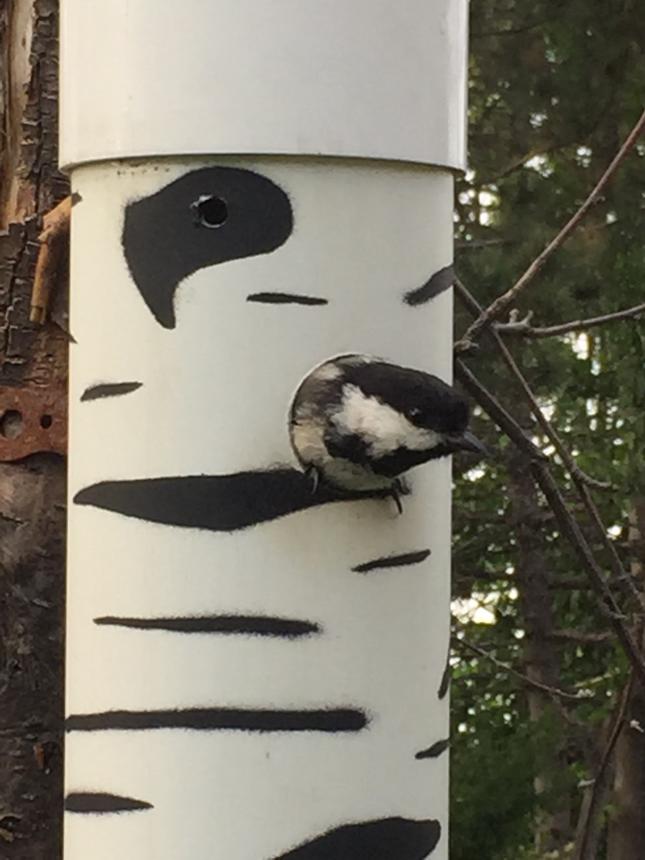Nesting Preferences of the Black-capped Chickadee - A Citizen Science Opportunity
The History of How it Started at WBU Toronto
Desiring to attract them to our backyards, we sell nest boxes appropriate for Black-capped Chickadees, traditionally advising they be filled with wood chips for the birds to excavate. However, the success rate has been lower than desired. We continuously seek information to enhance nesting success. In late spring of 2014, we discovered a study by the Cornell Lab of Ornithology from 2008 on Black-capped Chickadee nesting habits. Kyle Holloway, our store manager, and I found the results compelling. The study showed that PVC tube nest boxes filled with wood chips had higher success rates. The key findings were:
- Chickadees excavated nest tubes with wood shavings 60-70% of the time, compared to 40-50% for nest boxes.
- Chickadees initiated nests in tubes with wood shavings 25-30% of the time, versus 15% for nest boxes.
- Note: Boxes without wood shavings were least used.
Black-capped Chickadees are cavity nesters, meaning they prefer to nest within tree cavities. They often excavate their own nesting sites but may also use abandoned Downy Woodpecker cavities. For their own excavations, chickadees seek out soft spots on trees, such as where a branch has broken off, typically in dead alder or birch snags. They can nest in various environments, from suburban backyards to rural parks and natural forests.
Desiring to attract them to our backyards, we sell nest boxes appropriate for Black-capped Chickadees, traditionally advising they be filled with wood chips for the birds to excavate. However, the success rate has been lower than desired. We continuously seek information to enhance nesting success. In late spring of 2014, we discovered a study by the Cornell Lab of Ornithology from 2008 on Black-capped Chickadee nesting habits. Kyle Holloway, our store manager, and I found the results compelling. The study showed that PVC tube nest boxes filled with wood chips had higher success rates. The key findings were:
- Chickadees excavated nest tubes with wood shavings 60-70% of the time, compared to 40-50% for nest boxes.
- Chickadees initiated nests in tubes with wood shavings 25-30% of the time, versus 15% for nest boxes.
- Note: Boxes without wood shavings were least used.
The study information can be viewed here - Cornell Chickadee Artificial Nest Box Summary and Cornell BirdScope Article On Chickadee Nest Tube. Based on the study these findings were significant:
Kyle built several PVC chickadee nest tubes for trials, installed early in the summer. Although we didn't see success, we attributed this to the late installation rather than the design.
We ensured readiness with nest tubes for spring 2015. One was installed in Kyle's yard, another in his parents' yard, and one in ours. Several PVC nest tubes were also set up in Algonquin Park. The success was notable: Kyle's tube housed a Red-breasted Nuthatch, and his parents' a Black-capped Chickadee, both fledging successfully. Our tube was inspected by chickadees but remained unused. The Algonquin tubes were excavated, though further details were lacking. Encouraged by the results, we planned to expand our study in 2016.
Kyle undertook the task of crafting PVC Chickadee nest tubes for retail. We designed two versions: one to mount atop a pole from our Advanced Pole System, and another that attaches to a tree trunk or pole with two cable wraps.
For more information on the Chickadee Nest Tube download our original 2016 BirdTracks.
The Chickadee Nest Tube Today
Chickadee Nest Tube Cable Ties Set-up
This is a chance to take part in a local Citizen Science project. Come in and ask us about this exciting opportunity.


